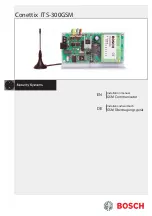
Company Confidential
s
Com
Copyright 2005© Siemens AG
Page
40
of
53
TD_Repair_L2.5_A70_A75_R1.0.pdf Release
1.0
Functions Pin
Requirements
Implementation/Sequence
Battery
temperature
supervision
Charging is stopped, when overtemperatur occurs. Within
128ms, 3 values are measured. When these 3 values are
identical status can be changed. The supervision is active in
fast charge or trickle charge mode. Voltage on pin TBAT
becomes smaller when temperature increases. If Vbat <
(Vref_exe - Vhyst) charging is disabled. Only when Vtbatt >
Vref_exe charging is enabled again.
Device
temperature
supervision
To protect the ASIC, the temperature is supervised. The
temperature is polled every 128ms and is filtered as in battery
temperature supervision. If overtemperatur is detected, a bit
in the STATUS register is set and an interrupt is generated.
Monitoring is started only in active mode.
Analog switch
Outport
The level can be defined by the bit out_port_high of the TWI
register. The high level can be derived of VREG2 or VREG3.
Additional a pulldown transistor is connected to this node.
TWI Interface
TWI_CLK,
TWI_DATA,
TWI_INT
The TWI interface is an I2C compatible 2-wire interface with
an additional interrrupt pin to inform the µC about special
conditions.
The interface can handele clock rates up to 400 kHz. The
device adress is 010001B (31H)
Audio mode
functions
Four audio amplifiers are integrated to support these modes:
1. Supply the speaker in the phone with audio signals
including the possibility of handsfree and antipop switch
on and off. This is the AUDIO MONO MODE.
2. Supply the speaker in the phone with ringing signal
(RINGER MODE)
3. Transfer a key click, generated in digital part to the
speaker. (KEY-CLICK FUNCTION)
4. Supply of stereo head set with stereo signal with short
circuit protection. This is called the AUDIO STEREO
MODE. These different modes with gain and multiplexing
can be controlled via TWI. Also the output can be
switched to TRI-STATE via TWI interface.
Audio Mono
Mode
VREGA
MONO1
MONO2
VREFEX_M
This mode is the main function of the amplifier. The two
amplifiers are used as differential mono amplifier to drive the
speaker in the phone as external load. This differential
approach allows delivering an optimum of power to the
speaker, also in low voltage mode. Both amplifier paths are
inverting amplifiers with external AC coupling at the input to
compensate offset failures. The gain can be adjusted with the
TWI interface. The output stage of the amplifiers must be able
to drive a low impedance load as a external speaker for the
handsfree application.
General parameters: Gain can be adjusted for each channel
separately in steps of 1.5dB in the range of 21dB to –54 dB
and in steps of 3 dB in the range of –54dB to –75dB. The
signals for the amplifier are connected via an audio
multiplexer with 3 pairs of input signals.














































